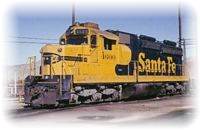
 |
 |
| Home | History | Roster | Prototype Gallery | Model Gallery |
Beginning in January 1973, the Santa Fe commenced the rebuilding of its 80-unit fleet of EMD SD24 locomotives. The 900-class fleet had been on Santa Fe property over 12 years, however the rate of locomotive technology had progressed rapidly over the years, and the minor upgrades to the SD24 fleet were put into place to bring about increased performance and increased cost savings for the ATSF instead of having to purchase an entirely new class of locomotive.
One of the reasons behind the rebuilding of the SD24 fleet was to improve a major shortcoming of the locomotive's design. The SD24 fleet was plagued with failures in the high-voltage and transition circuitry. The SD24s were also built before the development of the central air filtration system, thus the need for rebuilding.
The rebuilding of the SD24 fleet took place at Santa Fe's famed San Bernardino, California Shops between January 1973 and January 1978. The first SD24 through the program was #4533, and the last was #4508. The modifications necessary in upgrading the SD24 fleet, and transforming them into what Santa Fe called them, "SD26", were numerous. The four air reservoir tanks mounted on top of the long hood, just behind the cab roof, were moved. Two of the air tanks were moved toward the back roof on either side of the radiator section fans, and the other two were placed on either side of the dynamic brake fans. The locomotive bell was removed from the front pilot, and placed midway between the radiator fans and dynamic brake fans. Footboards were also removed. The most significant visual change was the shop force-built "hump", located directly behind the cab which housed the new inertial air filtering system.
Other changes included the installation of a second generation blower housing on the later rebuild units. New upgraded wiring, including EMD's new "Dash 2" circuit cards, were installed as well as extended range dynamic brakes. The prime mover was also replaced with shop forces removing the 16-567D3 and installing the new 16-645D3 engine, which in turn boosted a unit's horsepower rating from 2,400 to 2,625. The newly built SD26 class did retain their nose class lights, as well as their one-piece windshield.
All of the SD26 locomotives received cab roof-mounted air conditioners except #4603, #4604, #4607, #4608, #4620, #4623, #4625, #4629, #4630, #4631, #4636, #4637, #4638, #4640, #4643, #4646, #4648, #4651, #4652, #4655, #4656, #4659, #4663, #4665, #4668, #4671, #4674, #4677, and #4678. During the life of the rebuilt SD26 locomotives, the original SD24 blower bulge was replaced with the 2nd generation blower housing, and can be readily seen on #4600, #4610, #4613, #4618, #4644, #4653, #4674, and #4675. Although the SD26 class was originally rebuilt with one-piece windshields, by the early 1980's they had been retrofitted with two-piece windshields, similar in appearance to those in Santa Fe's GP20 locomotives. This move was done in order to have the same size and shape windshield glass across several classes of Santa Fe locomotives in order to simply maintenance part stockpiles.
Once the fleet was completed, and entered revenue service, Santa Fe assigned the SD26 locomotives to a variety of jobs around the system. Most were used in the general freight service, plying the rails on the Coast Lines, as well as serving in the Kansas City - La Junta - Albuquerque - El Paso freight pool.
SD26 numbers #4601, #4603, #4604, #4605, #4606, #4607, #4612, #4617, #4618, and #4675 were equipped for slug operation, and served in the Kansas City and Barstow hump yards.
An additional ten SD26 locomotives were also fitted as masters for the Locotrol system used in Remote Control Equipment (RCE) unit train service, which ranged from molten sulphur, to grain, potash, and coal). The Locotrol masters were #4611, #4627, #4629, #4690, #4645, #4648, #4667, #4674, #4677, and #4678.
During their years of service, only one SD26 was lost, and that was #4625, which was wrecked near Rustler Springs, TX in August 1974, and scrapped.
By 1985, most of the miles the SD26 would run over Santa Fe rails were completed and 44 units of the class were retired and traded to EMD in Spring 1985 for the #3840-#3854 series of GP50's. The specific locomotives were #4602, #4608, #4609, #4610, #4611, #4614, #4615, #4616, #4619, #4620, #4621, #4622, #4623 #4624, #4626, #4628, #4629, #4630, #4631, #4632, #4633, #4634, #4635, #4636, #4637, #4638, #4639, #4642, #4643, #4647, #4649, #4651, #4653, #4654, #4656, #4658, #4659, #4660, #4662, #4663, #4664, #4666, #4671, and #4672. The remaining 35 units remained on the Santa Fe roster until the end of 1986, at which time they were sold to Guilford Transportation Industries.
If one is interested in modeling the SD26, Overland Models Incorporated (OMI), has imported a HO scale locomotive. One can also follow Gregg Fuhriman's example within this website, or follow the article by Jim Volhard, in the August 2001 issue of Model Railroader.
QStation would like to thank Joe McMillan for his help in preparing this History Section on Santa Fe's unique SD26 locomotive.
| Statistics |
|---|
| Prime Mover | 16-645D3 | Truck Type | B-B | Weight | 328,000 lbs. |
| Length | 60' 8 1/2" | Drivers | 40" | Dynamic Brakes | XR |
| Width | 10' | Gear Ratio | 58:19 | Main Generator | D22 |
| Height | 15' 3/16" | Top Speed | 89 mph | ||
| Fuel Capacity | 3000 | Traction Motors | D47 |